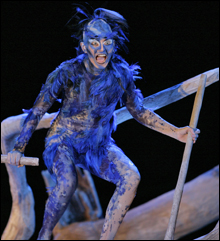
THE TEMPEST: Sometimes, but not always, rich and strange. |
I hadn’t been to the Santa Fe Opera in 35 years. In 1971, I spent the entire summer there, hanging out, painting sets, “acting” (I got to play the inquisition guard who arrests Verdi’s Don Carlo), and even writing my very first professional music review (for the Boston Globe) — about the posthumous world premiere of Villa-Lobos’s opera version of García Lorca’s Yerma. I learned a lot about how operas get produced, how careers get made (and unmade). I was all ears, and no threat. I listened to singers and musicians joke about their experiences and worry about their precarious futures.Now celebrating its 50th season, the Santa Fe Opera has grown into one of the country’s most venerable institutions. It was founded by conductor John Crosby, whose assistant, when I was there, was Richard Gaddes, who went on to start the St. Louis Opera Theatre. Then he replaced Crosby as director of SFO. It’s a remarkable organization. Established stars and promising newcomers mingle in each production. In 1971, Frederica von Stade, Theodore Uppman, and Donald Gramm were familiar presences. Kiri te Kanawa was making her American debut as the Countess in Mozart’s Le nozze di Figaro — just before her Covent Garden debut in that same role. No season goes by without a significant American or world premiere (there are now more than 50, including major works by Berg, Strauss, Stravinsky, and Henze), and few seats go unsold. Audiences trust the company, whose adventurousness pays off.
The chorus parts and smaller roles are taken by the young singers handpicked for the Santa Fe Opera’s apprentice program, the first of its kind in this country. (There’s also an apprentice program for technicians.) SFO has the reputation of having the most attractive chorus in the world. This year, two gifted mezzo-sopranos familiar to Boston appeared in featured roles: Paula Murrihy was the comical Second Lady in Mozart’s Die Zauberflöte (“The Magic Flute”) and Claudia Huckle the sympathetic Page in Strauss’s Salome. SFO even arranges two days of apprentice auditions for visitors from major opera companies. (“Death by aria,” David Holloway, head of the apprentice program, called it.)
The open-air theater itself is a model of high-tech sophistication and superior acoustics. In 1971, the dramatic adobe-like exterior, with its twin cantilevered roofs, left some of the best seats open to the elements; I shared many an umbrella during inclement-weather performances. Rebuilt in 1998, with an increased number of seats (2200), the theater now provides full cover overhead, though cool breezes still sweep across the hall. On clear nights, you can look through the stage and see the lights of Los Alamos glittering in the distance. There probably isn’t a more spectacular site for opera anywhere in the world. During the performance I saw of Thomas Adès’s The Tempest (based on Shakespeare’s late masterpiece — the second opera by the composer of the scandalous Powder Her Face, in its American premiere), flashes of real lightning seemed uncannily timed to the opening shipwreck.